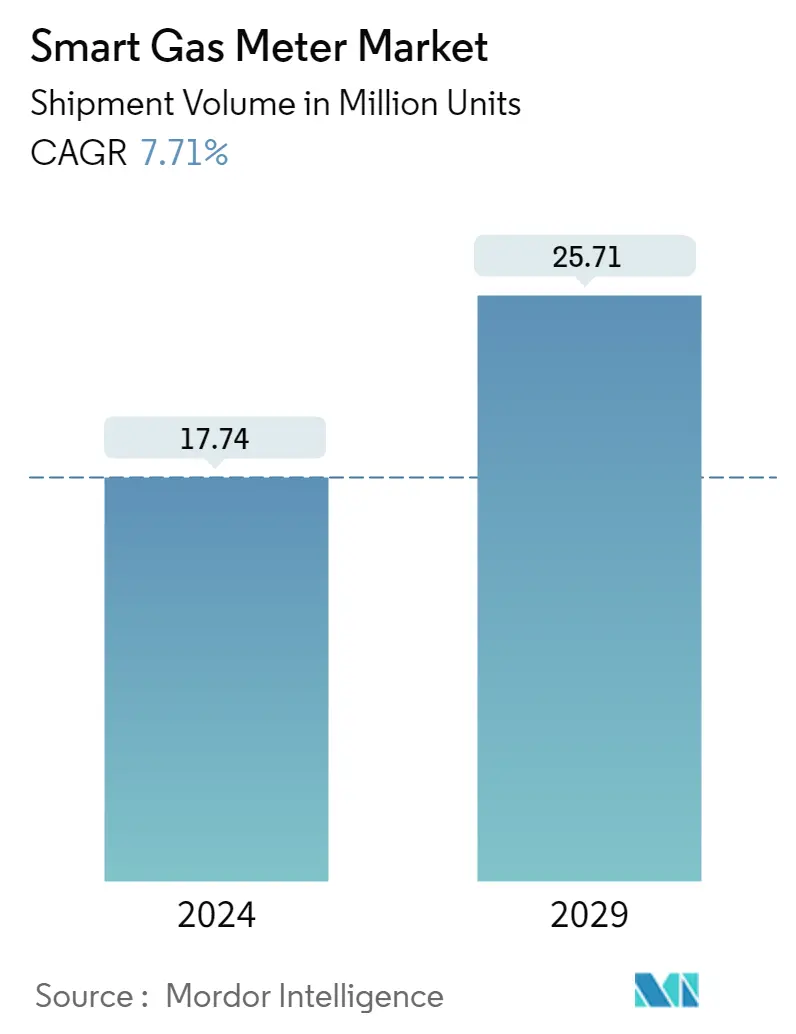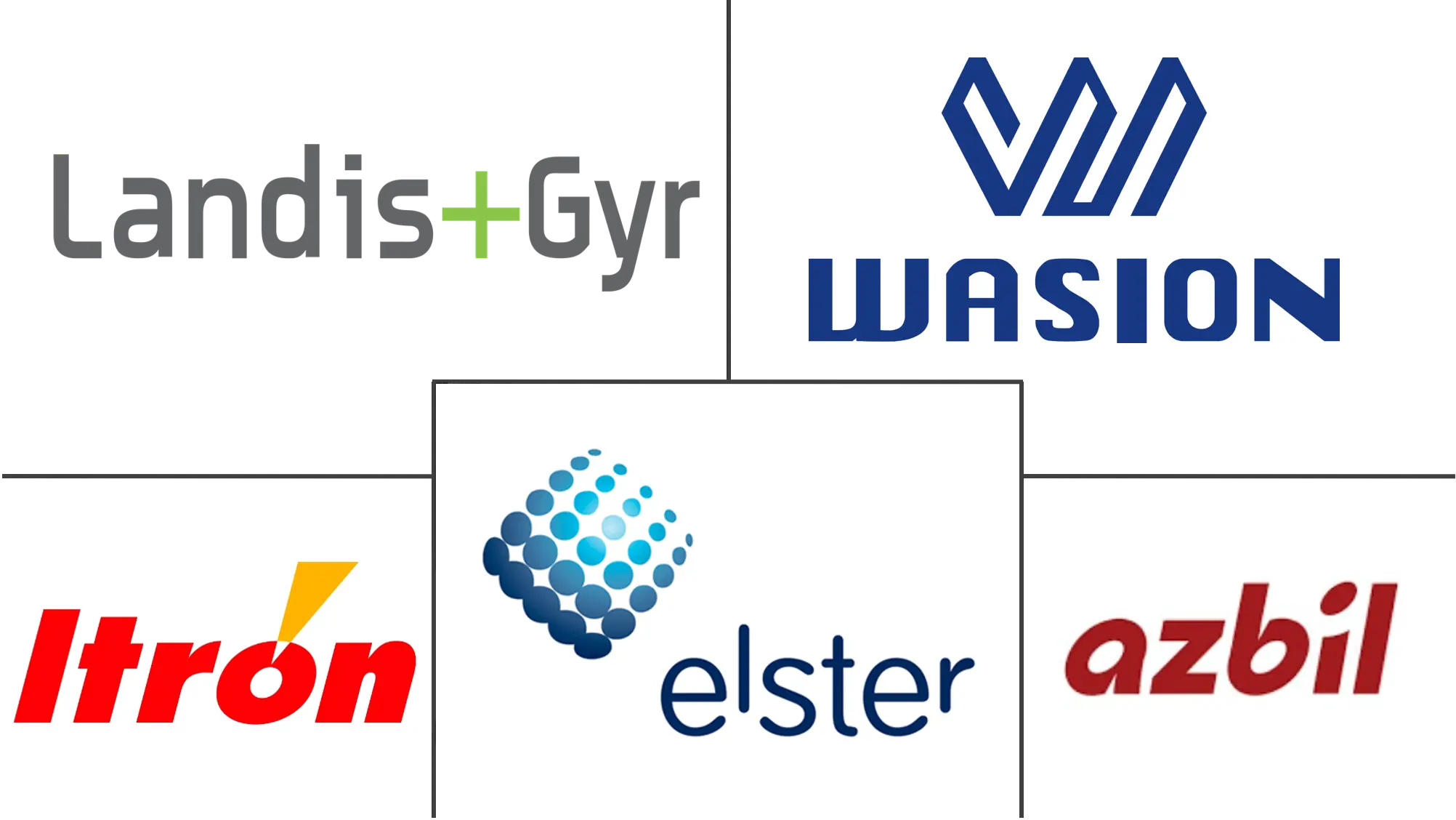Market Size of Smart Gas Meter Industry

| Study Period | 2019 - 2029 |
| Base Year For Estimation | 2023 |
| CAGR (2024 - 2029) | 7.71 % |
| Fastest Growing Market | Asia Pacific |
| Largest Market | Europe |
| Market Concentration | Low |
Major Players
*Disclaimer: Major Players sorted in no particular order |
Smart Gas Meter Market Analysis
The Smart Gas Meter Market size in terms of shipment volume is expected to grow from 17.74 Million units in 2024 to 25.71 Million units by 2029, at a CAGR of 7.71% during the forecast period (2024-2029).
The rise in global demand for natural gas, along with increasing demand for drill-down data among end-users, are the driving factors of the market growth.
- The adoption of smart gas meters on a large scale improves grid and distribution operations by allowing communication between other smart meters. The region under study's climate target and associated energy efficiency initiatives further encourage the adoption. Gas heating systems with smart meters use less fuel, indirectly contributing to developing a wholly automated grid. These developments are anticipated to accelerate the implementation of smart gas meters.
- Moreover, With the availability of next-generation IoT-optimized 5G technology, it is expected that there will be a shift from legacy RF platforms to emerging standards, like NB-IoT, in smart gas meters. Major companies, such as ITRON and Sensirion, are launching next-generation gas meters, like the SGM6200 series, with competitive prices and ultra-low current consumption to leverage the opportunity.
- Smart gas meters improve operational security while lowering gas companies' costs, which helps to drive the industry. The adoption of smart gas meters is fueled by the functional benefits they provide gas companies, such as the elimination of manually recording monthly readings, ongoing pipeline monitoring, and the availability of real-time data. Additionally, gas utility providers can use prioritized alarms and real-time data to raise the bar on safety.
- Moreover, Smart gas meters are technologically advanced compared with traditional gas meters. As a result, the cost of installing smart meters is typically higher than that of conventional meters, as a smart gas meter combines measurement and communication systems.
- The outbreak of COVID-19 significantly hampered the demand for gas meters from the regional gas sector. However, in 2021, the decline in COVID-19 cases led to the resumption of drilling activities and businesses reopening. This resulted in a slow economic recovery across the regions.
Smart Gas Meter Industry Segmentation
Smart gas meters use wireless networks to send consumption data directly to the supplier allowing infrastructure maintenance, remote location monitoring, and automatic billing. It comes with an in-home display that gives consumers real-time usage information.
The Global Smart Gas Meter Market is segmented by Geography (North America, Europe, Asia Pacific, and Latin America).
The market sizes and forecasts are provided in terms of value (USD million) for all the above segments.
| By Geography | ||||||||
| ||||||||
| ||||||||
| ||||||||
|
Smart Gas Meter Market Size Summary
The smart gas meter market is poised for significant growth, driven by the increasing global demand for natural gas and the need for detailed data among end-users. The widespread adoption of smart gas meters enhances grid and distribution operations by facilitating communication between meters, aligning with climate targets and energy efficiency initiatives. The transition to next-generation IoT-optimized technologies, such as NB-IoT, is expected to further propel the market, with major companies like ITRON and Sensirion leading the charge with innovative products. These advanced meters offer operational security and cost savings for gas companies by automating processes and providing real-time data, although their higher installation costs compared to traditional meters pose a challenge. The market's expansion is also supported by the recovery from COVID-19 disruptions, which had previously impacted demand.
In Europe, the United Kingdom stands out with its robust government initiatives and infrastructure supporting the rollout of smart gas meters, driven by the need to reduce greenhouse gas emissions and improve gas flow efficiency. The region's investment in smart grids and sophisticated technologies is expected to accelerate adoption further. The global market is characterized by fragmentation, with key players like Wasion Group Holdings and Landis + GYR Group AG striving to maintain competitiveness through joint ventures and technological advancements. Recent developments, such as Itron's release of the Intelis gFlex prepayment gas meter and collaborations for deploying advanced metering solutions, highlight the industry's focus on enhancing product capabilities and expanding market reach.
Smart Gas Meter Market Size - Table of Contents
-
1. MARKET INSIGHTS
-
1.1 Market Overview
-
1.2 Industry Value Chain Analysis
-
1.3 Industry Attractiveness - Porter Five Forces
-
1.3.1 Bargaining Power of Suppliers
-
1.3.2 Bargaining Power of Buyers
-
1.3.3 Threat of New Entrants
-
1.3.4 Threat of Substitutes Products and Services
-
1.3.5 Intensity of Competitive Rivalry
-
-
1.4 Assessment of the Impact of COVID-19 on the Industry
-
1.5 Natural Gas Domestic Consumption Statistics (2010-2020)
-
1.5.1 North America
-
1.5.2 Europe and CIS
-
1.5.3 Asia Pacific
-
1.5.4 Latin America
-
1.5.5 Middle East
-
1.5.6 Africa
-
-
-
2. MARKET SEGMENTATION
-
2.1 By Geography
-
2.1.1 North America
-
2.1.1.1 United States
-
2.1.1.2 Canada and Central America
-
-
2.1.2 Europe, Middle East and Africa
-
2.1.2.1 Europe
-
2.1.2.2 CIS
-
2.1.2.3 Middle East
-
2.1.2.4 Africa
-
-
2.1.3 Asia Pacific
-
2.1.3.1 China
-
2.1.3.2 Japan
-
2.1.3.3 South Korea
-
2.1.3.4 Australia and New Zealand
-
2.1.3.5 India
-
2.1.3.6 Rest of Asia Pacific
-
-
2.1.4 Latin America
-
2.1.4.1 Brazil
-
2.1.4.2 Mexico
-
2.1.4.3 Argentina
-
2.1.4.4 Rest of Latin America
-
-
-
Smart Gas Meter Market Size FAQs
How big is the Smart Gas Meter Market?
The Smart Gas Meter Market size is expected to reach 17.74 million units in 2024 and grow at a CAGR of 7.71% to reach 25.71 million units by 2029.
What is the current Smart Gas Meter Market size?
In 2024, the Smart Gas Meter Market size is expected to reach 17.74 million units.

